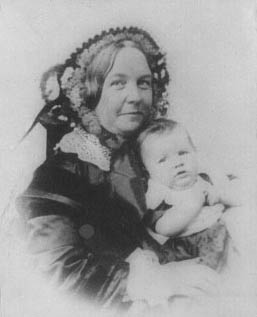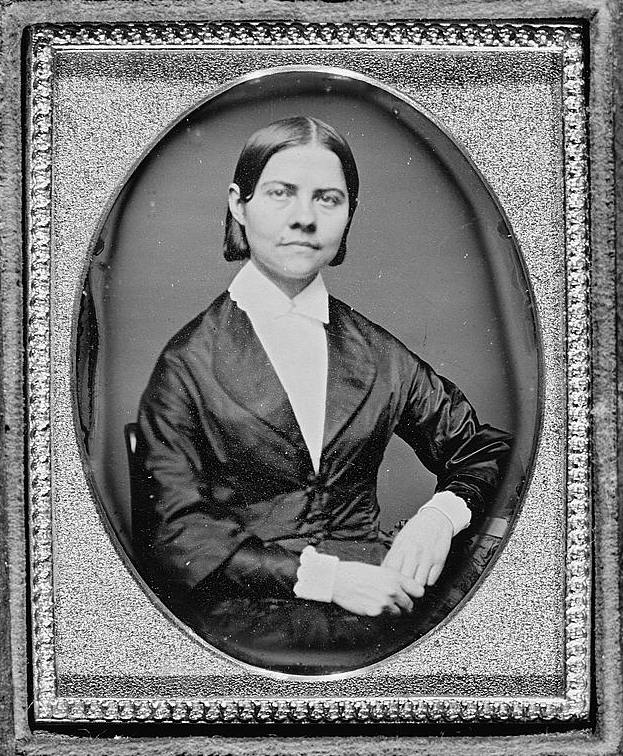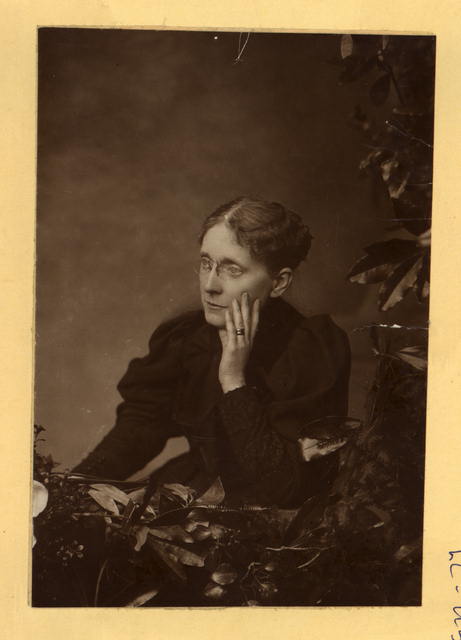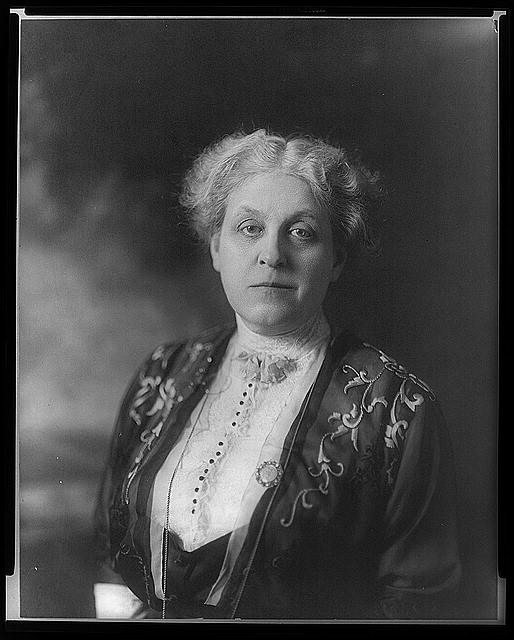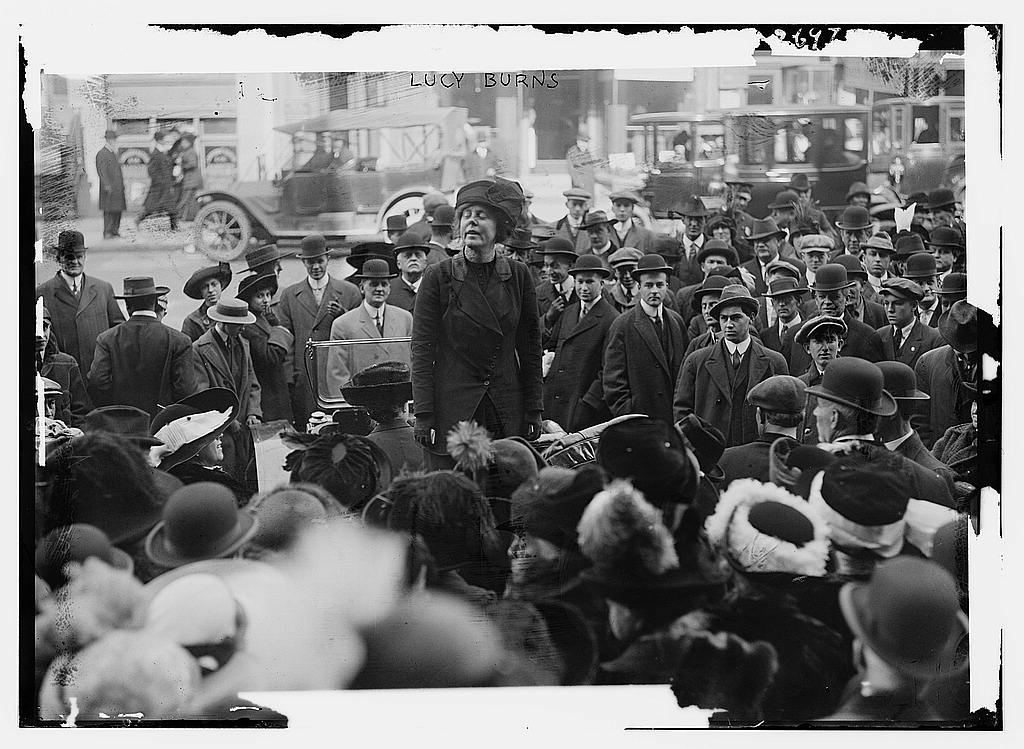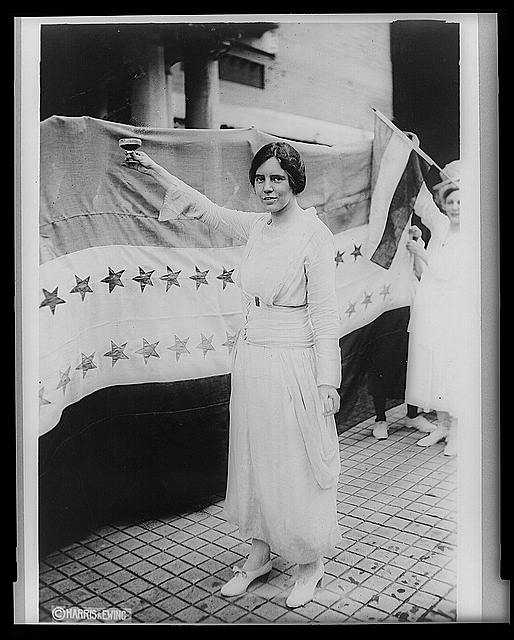The 19th Amendment not only gave women the right to enfranchisement in all elections, and thus a say in government, it also legitimized women's participation in all areas of society.
The history of women gaining the right to vote in the United States intertwines with American women gaining other rights as well. Although the "founding mothers" of American women's enfranchisement -- among them, Lucretia Mott, Elizabeth Cady Stanton, Susan B. Anthony, and later Carrie Chapman Catt and Alice Paul -- would always see women's suffrage as their number one priority; they would recognize that with the right to vote, would come other rights also.
Seneca Falls
Lucretia Mott met Elizabeth Cady Stanton when both attended the World Anti-Slavery Society convention in London in 1840. When denied a place on the floor with the rest of the female delegates, Mott and Cady Stanton resolved that what was needed was a meeting for women to discuss how they could secure the same rights as men.
Not until almost eight years later would the two women finally make good on their agreement, calling for a convention in 1848 in Seneca Falls, New York, "to discuss the social, civil, and religious condition and rights of woman." Seneca Falls would become the genesis for the women's rights movement.
At Seneca Falls, Elizabeth Cady Stanton would present the Declaration of Sentiments and Resolutions, based on the American Declaration of Independence. Among the demands in the declaration was equality with men before the law, in education and employment. Here, too, was the first pronouncement demanding that women be given the right to vote. The assembled crowd of over 300 -- including about 40 men -- passed all the resolutions except the one giving women the vote. It was not until Frederick Douglass, the great black orator and abolitionist, spoke to the assembly advocating women's enfranchisement that the delegates passed this resolution also. From this point on, gaining the right to vote would be the rallying cry at every successive women's rights convention until passage of the 19th Amendment.
Over the next 50 years, Elizabeth Cady Stanton would continue the drive for women's rights and enfranchisement, with abolitionist and temperance supporter, Susan B. Anthony. Although she had not attended the convention at Seneca Falls, Anthony's Quaker upbringing, in which women were regarded as equals both in and outside the church, had not prepared her for the rest of the world's views on women. While attending a temperance meeting in 1852, she rose to speak on a motion. "The sisters were not invited to speak," the presiding officer chastised, "but to listen and learn." From that moment on, she would devote the rest of her life working with Cady Stanton for women's rights.
From the convention in Seneca Falls, a revolution would take place concerning women's rights. Women were gradually allowed to speak in public, something that had been strictly forbidden before. Individual states adopted laws protecting the rights of married women, granting them the right to own property in their own name, keep their own earnings and retain guardianship of their children in case of divorce. But with the advent of the Civil War, women's rights, and especially women's enfranchisement, began to take a back seat to the abolition of slavery, and hence to securing the black male's right to vote.
Although Elizabeth Cady Stanton and Susan B. Anthony were staunch abolitionists, they were aware of women's contributions to the war effort, and they felt that any suffrage gained should first go to women. With the passage of the 13th Amendment in 1868 abolishing slavery, they were once again ready to begin the fight for female suffrage. But Republican politicians, as well as male abolitionists, cautioned to "Let this be the Negro's hour!" Despite their protests, Cady Stanton and Anthony watched as the 15th Amendment, giving black males the vote, passed in 1870. Although they would try to introduce a 16th Amendment providing that suffrage be based on citizenship irrespective of race, color or sex, it was ignored.
The National Woman Suffrage Association
Even women were split over the results of the 15th Amendment, however. In 1869 Cady Stanton and Anthony had formed the National Woman Suffrage Association (NWSA) to begin an all-out campaign for women's enfranchisement. The NWSA was primarily a women's organization, attracting younger women, especially from the West, who were more outspoken and ready to fight for their right to vote. Most importantly, the NWSA wanted a federal amendment for women's suffrage.
In opposition to the NWSA's radical approach, an up-and-coming feminist, Lucy Stone, formed the American Woman Suffrage Association (AWSA). Stone felt that it did not matter if free black males gained the vote first, as long as the fight for women's suffrage continued. The AWSA admitted men and was able to draw those women "who wanted to vote, but didn't want to tamper with traditional views of marriage or divorce, or become involved in controversial issues." The AWSA worked toward state and local suffrage first, with the ultimate goal of national suffrage.
Anthony and Cady Stanton canvassed the country, speaking before women's groups and state legislatures, urging women in individual states to form their own organizations to secure women's right to vote. They were particularly successful in the West, where the pioneer spirit prevailed, and men and women alike endured hard conditions and thus were seen as equals. When the territory of Wyoming was formed in 1869, it gave women the vote in all elections. Women would retain their right to vote when Wyoming became a state in 1890. Over the next half-century, 13 states, most of them in the West, would give women some form of political enfranchisement.
After the 14th and 15th Amendments passed, suffragists decided that they needed a test case to challenge in court their right to vote. Susan B. Anthony was first, when she and her sisters tried to register to vote in Rochester, New York, in 1872. When the registrar refused, Anthony read aloud from the 14th Amendment, which she claimed superseded the New York state constitution. Two voting inspectors agreed with her, and let the sisters register. When Election Day came, officials allowed the women to vote. But two weeks later, they were arrested and indicted under an 1870 act of Congress making it illegal for a woman to vote. Anthony thought if she refused to pay bail, the case would go to court and she would have a chance to bring her argument before the Supreme Court. But her lawyer, fearing what might have awaited her in jail, paid her bail and she was denied the chance to appeal.
The test case for suffragists came three years later in 1875 when Virginia Louisa Minor brought suit against Reese Happersett, the registrar of St. Louis, Missouri, based on his refusal to register her as a legal voter. Minor claimed that the state constitution and registration law, limiting the right to vote to men, was a denial of her rights as a citizen under the 14th and 15th Amendments to the U.S. Constitution. Although she lost the trial in the Missouri Circuit Court, an intermediate appellate court and the Missouri State Supreme Court, the U.S. Supreme Court granted a review. The decision delivered by Chief Justice Morrison Waite presented the question as to whether all citizens were necessarily voters. Citing that "The Constitution does not define the privileges and immunities of citizens," Chief Justice Waite added, "Women were excluded from suffrage in nearly all the States by the express provision of their Constitutions and laws .... The right of suffrage, when granted, will be protected ... but in order to claim protection she must first show that she has the right."
Women and the Temperance Movement
Throughout the latter half of the 19th century suffragists would continue to put out fires. One of the biggest anti-suffrage industries was liquor manufacturing. As early as 1866, the United States Brewers' Association had organized not only to further its own interests, but also to ensure its political protection against women's suffrage. The liquor industry was not entirely wrong in its concern, for the call for suffrage would surge ahead through the temperance movement in the person of Frances Willard.
In 1874, women from 17 states met in Cleveland, Ohio, to form the Women's Christian Temperance Union (WCTU). Women had always been advocates of temperance, mostly because of the lack of laws protecting women and children from abusive husbands and fathers, who were also heavy drinkers. For example, a man could take his wife and children's earnings and spend it on liquor instead of food.
Frances Willard had grown up in a home where her father had made all the decisions -- even on what dresses his daughters wore. She realized that most women would not stand up to men and demand their rights, but, through temperance, she saw the chance to gain suffrage and other rights also.
With the premise that women had to be gently led into suffrage, Willard began her crusade within the WCTU. First as corresponding secretary, and later as president, she built up the WCTU so that it would eventually become the largest women's organization in the world. Her message was simple: in order for women to keep their home and family intact, they must seek the vote, for, with suffrage, then could they begin to realize other agendas. With the slogan "Home Protection," she brought in women, men and also the clergy, who would come to see the WCTU as providing a respectable framework for suffrage.
Conflict within the Movement
By 1890, the National Woman Suffrage Association and the American Woman Suffrage Association merged to become the National American Woman Suffrage Association (NAWSA). The suffrage movement had again begun to disintegrate, however. Although Susan B. Anthony was as committed as ever, Elizabeth Cady Stanton was tiring of the fight. She still believed that women needed the vote, but she also believed that women needed other rights as well, and she wanted to devote her remaining years to gaining those rights. Still, her name and reputation brought women into the suffrage movement, and at age 75, she reluctantly accepted the presidency of the NAWSA. As first Cady Stanton, and then Anthony, began to fade from the scene, a new national leader would begin her rise in the suffrage movement.
Beginning at the first NAWSA convention in 1890, and continuing for the rest of the decade, Carrie Chapman Catt would gather around her a cadre of women who would work long campaigns throughout the states to win the right to vote. Succeeding Susan B. Anthony as president of the NAWSA in 1900, Catt would bring the organization into the 20th century.
Catt's adeptness at uniting different factions into one cohesive women's rights machine enabled her to pursue the goal of state suffrage. In order that suffrage would appeal to various segments of the population, she came up with the idea of setting aside certain days for certain occupations to participate in special events related to suffrage. Clergymen were asked to preach suffrage sermons. Theaters and movie houses allowed suffragists to give speeches at intermissions. Windows of vacant stores were adorned with suffrage displays. A campaign school for workers taught them how to canvass towns and hamlets in gaily-decorated mobile headquarters, garnering support.
However, by 1912, there were again rumblings of a split within the women's suffrage movement. Alice Paul, a product of the gains that women's rights had made, became impatient with what she saw as the never-ending process of gaining state support for women's enfranchisement. She had spent her middle 20s in England, where she became a disciple of Emmeline Pankhurst, the British suffragist. While there, she met another American, Lucy Burns. The two were constantly arrested with British suffragettes for holding demonstrations outside meetings where politicians such as Herbert Asquith, David Lloyd George and Winston Churchill were in attendance. The two American women would see militancy as the solution for women's right to vote in the United States. A year after returning to the states, they would break away from the NAWSA in 1913 and form the Congressional Union. The heart of the matter as Paul and Burns saw it was to go directly to Congress and more importantly, the president.
Growing Impatience
Thus, when Woodrow Wilson arrived at the train station in northeast Washington the day before his inauguration in 1913, he was somewhat surprised to see no people on the platform. "Where are the crowds?" he asked. "Over on the Avenue watching the suffrage parade," was the reply. Alice Paul, seizing the opportunity of addressing a brand new president on the question of suffrage, had planned a parade to coincide with Wilson's arrival.
More than 5,000 women had gathered to bring home the point that women needed the vote: now. The crowd, most of whom had come for the inauguration, were far from friendly toward the suffragettes, however. Although Paul had obtained a police permit for the parade, police protection for the marchers was almost nonexistent. The suffragettes had to fight their way along the street, only able to walk three abreast at some points. They were subjected to taunts, spitting, slapping and burning cigars being thrown at them. The bedlam created caused army troops to be called out to settle things down. Later, when Paul got the chance to ask Wilson what his intentions were toward suffrage, the president replied that he would have to have more information before making up his mind. From that point on, she would not let Woodrow Wilson forget the issue of woman's suffrage.
Paul organized young enthusiastic girls who would move to each state, visiting newspapers and calling on women who lived there to serve on vote-getting committees. Once the girls had established themselves, the Congressional Union would send out a speaker. From there, each girl would move to a new town, until every town in a state had been canvassed, whereby the girl would return to Washington and make a report to the congressman who represented a particular area. Throughout 1913, Alice Paul and her legions continued this tactic, but the majority-Democratic Congress refused to act. She was not deterred, however. In the 1914 elections, Paul urged suffragists to support only Republican candidates. Even though her strategy did not work, she wasn't upset. She had only wanted to keep the pot stirring, because her eye was on the future.
After an absence of more than 10 years at the helm, Carrie Chapman Catt was again elected president of the NAWSA in 1915. Throughout the next year, she would endorse a more flexible program in which support of the federal amendment would be combined with action to increase the number of states in which women could vote. Although she still believed that a state-by-state referendum for enfranchisement was needed, she understood Alice Paul's drive and determination. They would each work for the vote in their own way, and each would gain advances.
But Alice Paul was again impatient. When she had advance information that Woodrow Wilson's annual message to Congress in December 1916 contained no reference to suffrage, she planned an even bigger event than the parade she had staged prior to his inauguration in 1913. Beginning in January 1917, suffragists began picketing the White House, something that had never been done before. Through cold and snow, rain and wind, each day the suffragettes would show up. As Carrie Chapman Catt had organized her workers around themes, so would Alice Paul. Special days for picketers from different states, a college day, a teacher's day -- even Susan Anthony's birthday -- kept the movement going.
When Congress declared war on Germany in April 1917, the pickets continued despite threats of arrest, for the suffragettes had been going strong for almost six months. Not even arrest and jail could stop them. Conditions in the workhouse where they were sent were appalling and the superintendent was belligerent toward them. After large play in newspapers nationwide, protests of their treatment came from around the country, so much so, that those who had been against suffragists previously began supporting their cause. It even became fashionable to picket for suffrage and then serve time in jail. By the end of 1917, six state legislatures had granted presidential suffrage, including Rhode Island, the first state in the East.
An Amendment Passes
After several votes on an amendment for women's suffrage, the U.S. House of Representatives passed the bill on January 10, 1918. At this time, Russia and Canada had given women the vote, Germany was at the point of doing so, and England had promised women the vote after the war. Even Woodrow Wilson had come out on the side of suffrage, urging the Senate to pass an amendment. But the largely Democratic Senate was unwilling to even debate the bill until September 1918, when they refused to pass it.
Not until May 1919 did Congress turn its attention back to the suffrage amendment. The House of Representatives again passed the bill, this time with a staggering vote, 304 to 90. Once more hotly debated in the Senate, the amendment finally passed with 66 votes, two more than were needed.
In the 71 years since Elizabeth Cady Stanton had called women to Seneca Falls, there had been 56 referenda campaigns, 480 state legislature campaigns and 277 state party convention campaigns to write suffrage into state constitutions, and 19 Congresses where a woman's suffrage amendment had been introduced. It would take another 15 months and more fulltime battles to get the required 36 states to ratify the 19th amendment.
After ratification, both Carrie Chapman Catt and Alice Paul would continue their crusades for women's rights, moving more into the international arena. At the 1919 NAWSA convention, Catt had called for the establishment of the League of Women Voters; and in 1923, Paul would introduce the Lucretia Mott amendment to Congress, the first equal rights amendment to the Constitution.
